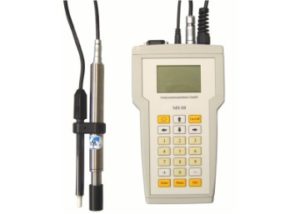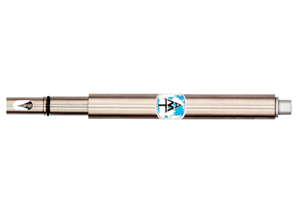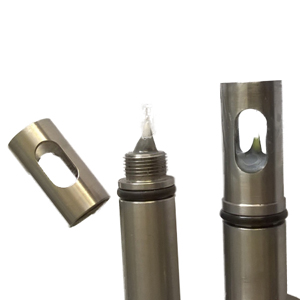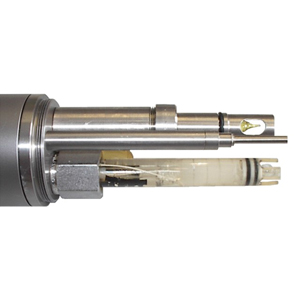hydrogen peroxide micro-sensor
determination of dissolved hydrogen peroxide in aqueous solutions ES-H2O2-M
overview
Determination of dissolved hydrogen peroxide in aqueous solutions
The amperometric H2O2 micro-sensor has been developed for the in situ determination of hydrogen peroxide-containing aqueous solutions. Therefore the sensor is suitable for direct measurements in coloured and turbid solutions (wastewater), in industrial plants, and also in biological research. Compared with all the other commercially available hydrogen peroxide sensors, this Amperometric H2O2 micro-sensor works with such a low analyte consumption that streaming of the sensor membrane or stirring of the analyte is not necessary. And an additional stirrer is not necessary for stationary measurements. The second advantage of the AMT-micro-sensor is the very fast response time with t90% =1-2 seconds. The third advantage of the new micro-sensor is based on the micro-sensor technology itself. High signal stability and high local signal resolution allow some new applications, for instance, the profiling in μm-steps.
industrial plants, and also in biological research. Compared with all the other commercially available hydrogen peroxide sensors, this Amperometric H2O2 micro-sensor works with such a low analyte consumption that streaming of the sensor membrane or stirring of the analyte is not necessary. And an additional stirrer is not necessary for stationary measurements. The second advantage of the AMT-micro-sensor is the very fast response time with t90% =1-2 seconds. The third advantage of the new micro-sensor is based on the micro-sensor technology itself. High signal stability and high local signal resolution allow some new applications, for instance, the profiling in μm-steps.
The general working principle of the sensor
Because of the partial pressure of the gaseous H2O2 dissolved in the sample, the analyte is separated from the inner electrolyte by means of the membrane. The membrane is only pervious to gases so that liquids, ions and solids are not able to reach the inner electrolyte or the electrodes of the sensor. The sensor contains inside a special electrolyte and 3 electrodes. The electrode materials have been carefully selected and prepared to realize ideal electrochemical conditions. The time for the polarization, realized by means of the sensor’s integrated electronic device, is approximately 5…15 minutes after the first switching on or during long breaks. If the H2O2 has passed now the membrane, it reacts chemically with the redox catalyst and forms a new compound. After this, this compound is transported by diffusion to the working electrode, followed by the electrochemical reaction. This causes a current depending on the hydrogen peroxide partial pressure/hydrogen peroxide concentration of the sample. The observed current within a range of 0...400 picoamperes is converted into a voltage of 0...5 Volt inside the integrated electronic device of the sensor. Besides in opposite to other measuring principles, the current flow in the amperometric sensor leads to a rapid decrease of the analyte inside the sensor resulting in very fast response times even though there is a concentration jump from high to low concentrations.
All commercially available electrochemical sensors have to be combined with temperature measurement and the amperometric H2O2 sensor too. When ordering a multi-sensor measuring system for laboratory use or a complete submersible probe system, the temperature measurement and the temperature correction of the sensor signal is already included. If measurements in a flow-through system are required, special temperature sensors for the integration in AMT flow-through cells are offered. When measuring in opened vessels or beakers in the laboratory, the customers have to realize the temperature measurement themselves. If a calibrated sensor is ordered, the temperature correction is very easy by means of a factor or for more accurate measurements by means of a mathematical formula delivered with the sensor.
specifications
| feature | specification |
|---|---|
| measuring principle | amperometric membrane covered micro-sensor |
| sensor | 3 sensor electrodes |
| Polarisation voltage | Polarisation voltage necessary (realized by means of the integrated electronics) |
| polarization time | necessary time for the polarization: approx. 5-15 minutes |
| streaming or stirring of the membrane | streaming of the membrane or stirring is not necessary, low analyte consumption |
| measuring ranges | - type I: 0,02…10% H2O2 others on request |
| sensor head | exchangeable |
| accuracy of the sensor | ± 1% f.s. |
| temperature range | 0°C to 30°C |
| pH range | 0…11 |
| response times | t90%: 1-2 seconds |
| lifetime | approximately 5-9 months, influenced by the sample’s matrix and H2O2 stress |
| pressure stability | laboratory sensor or shallow water version for pressures of up to 10 bar |
| no cross sensitivities against | carbon dioxide, oxygen, methane, hydrogen, ammonia, carbon monoxide, organic solvents (less than 20% in aqueous solutions), acetic acid, dimethyl sulphide, HCN, solids |
| measuring signal | No influence of the measuring signal in case of salt concentrations less than 40 g/l |
| concentration gradients | suitable for the determination of concentration gradients with high local resolution |
| housing | all housings are made of titanium |
| Technical data for all H2O2 micro-sensor heads independently from the sensor design *) | *) Changes for technical improvement are reserved. |
manual & docs
related products







